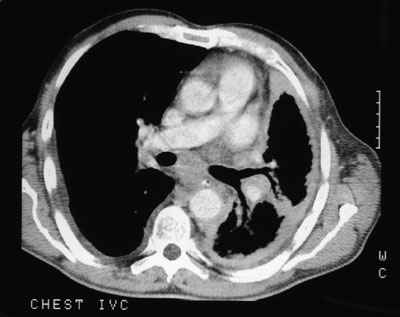The risk factor that can cause mesothelioma is exposure to asbestos fibers , particularly volatile, which are easily inhaled, just think that an asbestos fiber is 1300 times thinner than a human hair.
Mesothelioma is a rare and serious cancer, which mainly affects the membrane lining the lung (pleura) or the intestine (peritoneum). This evil owes part of its danger to the difficulty with which it is diagnosed. Typical symptoms are chest pain and difficulty breathing, factors common to many other lung diseases. The best method at the moment remains the biopsy. Once the presence of a malignant mass has been verified, it is possible to intervene with complete surgical removal, associated with cycles of chemotherapy. It is important to underline that new drugs are being tested (some of them are one step away from being approved by the FDA – Food and Drugs Administration), capable of helping the cure by blocking tumor cells. Italy is the European country with the highest number of people affected by this form of cancer, often contracted in the workplace. In fact, asbestos was used for the insulation of buildings, roofs, ships, trains, in construction for tiles and floors, in firefighters' suits, in car paints and even for houses. Its harmfulness to health has led to its use being banned in our country with law 257/1992 and INAIL, in the event that diseases connected to it are contracted, such as mesothelioma, it recognizes and pays a disability allowance .

In the photo above on the left, a sign indicating an area contaminated by asbestos (asbestos in English). Above, a microscope photo of an asbestos fiber. Under a tomography in which the presence of mesothelioma is noted.

You may also like
Business Phone Subscriptions: Guide to Costs, Options and Benefits
Choosing a business phone subscription can be a complex task, with numerous factors such as costs, benefits, and options to consider. This article explores various business phone subscriptions, examining the best deals and geographic cost variations to help businesses make informed decisions.
Private Mobile Phone Subscriptions: Finding the Best Fit for Your Needs
Selecting a mobile phone subscription can be daunting with myriad plans and hidden costs. This article explores various phone plans for private use, comparing prices and highlighting key considerations to help you choose the best mobile service provider.
Green Energy and Charging Stations: Proposals and Costs
As the world shifts towards greener energy sources, the demand for electric vehicle (EV) charging stations is on the rise. This article examines the current landscape of EV charging infrastructure, comparing proposals, costs, and benefits. We delve into geographic cost variations and spotlight the most competitive charging station offers.
Analysis of Green Energy Through Photovoltaic Panels
As the world searches for sustainable solutions to combat climate change, solar energy emerges as a frontrunner. This article explores the various proposals, costs, and advantages associated with photovoltaic panels, providing a comprehensive guide to understanding and investing in solar power. It also delves into geographical cost variations and compares current market offerings for optimal decision-making.
